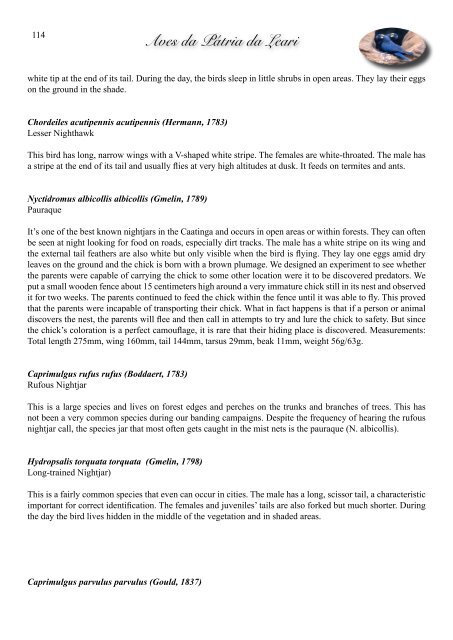Aves da Pátria da Leari - Sociedade Brasileira de Ornitologia
Aves da Pátria da Leari - Sociedade Brasileira de Ornitologia
Aves da Pátria da Leari - Sociedade Brasileira de Ornitologia
Create successful ePaper yourself
Turn your PDF publications into a flip-book with our unique Google optimized e-Paper software.
114<br />
<strong>Aves</strong> <strong>da</strong> <strong>Pátria</strong> <strong>da</strong> <strong>Leari</strong><br />
white tip at the end of its tail. During the <strong>da</strong>y, the birds sleep in little shrubs in open areas. They lay their eggs<br />
on the ground in the sha<strong>de</strong>.<br />
Chor<strong>de</strong>iles acutipennis acutipennis (Hermann, 1783)<br />
Lesser Nighthawk<br />
This bird has long, narrow wings with a V-shaped white stripe. The females are white-throated. The male has<br />
a stripe at the end of its tail and usually flies at very high altitu<strong>de</strong>s at dusk. It feeds on termites and ants.<br />
Nyctidromus albicollis albicollis (Gmelin, 1789)<br />
Pauraque<br />
It’s one of the best known nightjars in the Caatinga and occurs in open areas or within forests. They can often<br />
be seen at night looking for food on roads, especially dirt tracks. The male has a white stripe on its wing and<br />
the external tail feathers are also white but only visible when the bird is flying. They lay one eggs amid dry<br />
leaves on the ground and the chick is born with a brown plumage. We <strong>de</strong>signed an experiment to see whether<br />
the parents were capable of carrying the chick to some other location were it to be discovered pre<strong>da</strong>tors. We<br />
put a small woo<strong>de</strong>n fence about 15 centimeters high around a very immature chick still in its nest and observed<br />
it for two weeks. The parents continued to feed the chick within the fence until it was able to fly. This proved<br />
that the parents were incapable of transporting their chick. What in fact happens is that if a person or animal<br />
discovers the nest, the parents will flee and then call in attempts to try and lure the chick to safety. But since<br />
the chick’s coloration is a perfect camouflage, it is rare that their hiding place is discovered. Measurements:<br />
Total length 275mm, wing 160mm, tail 144mm, tarsus 29mm, beak 11mm, weight 56g/63g.<br />
Caprimulgus rufus rufus (Bod<strong>da</strong>ert, 1783)<br />
Rufous Nightjar<br />
This is a large species and lives on forest edges and perches on the trunks and branches of trees. This has<br />
not been a very common species during our banding campaigns. Despite the frequency of hearing the rufous<br />
nightjar call, the species jar that most often gets caught in the mist nets is the pauraque (N. albicollis).<br />
Hydropsalis torquata torquata (Gmelin, 1798)<br />
Long-trained Nightjar)<br />
This is a fairly common species that even can occur in cities. The male has a long, scissor tail, a characteristic<br />
important for correct i<strong>de</strong>ntification. The females and juveniles’ tails are also forked but much shorter. During<br />
the <strong>da</strong>y the bird lives hid<strong>de</strong>n in the middle of the vegetation and in sha<strong>de</strong>d areas.<br />
Caprimulgus parvulus parvulus (Gould, 1837)

















